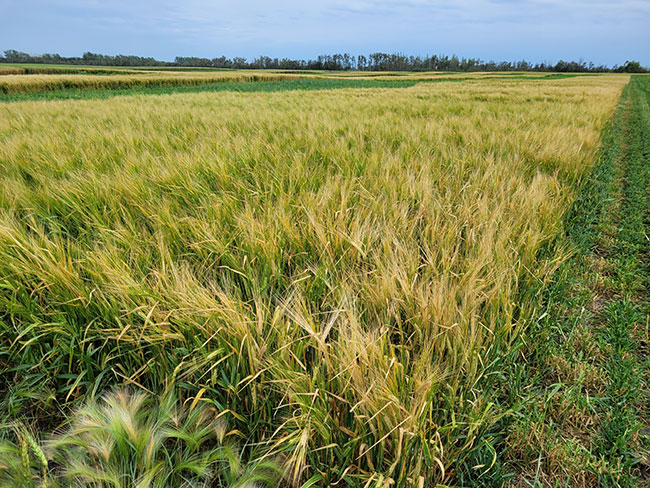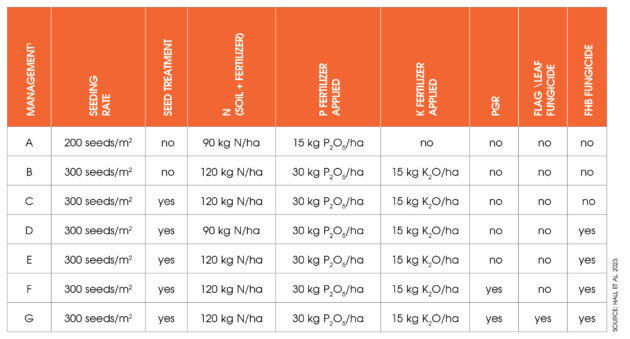
Features
Agronomy
Malt barley to the max
Malt barley benefitted from intensive management when yield potential was high.
August 23, 2023 By Bruce Barker
 At high yielding sites, barley responded to some additional inputs.
Photo courtesy of MIKE HALL.
At high yielding sites, barley responded to some additional inputs.
Photo courtesy of MIKE HALL. Malt barley yield potential continues to move higher, which begs the question: Should input levels be intensified? A three year research study in Saskatchewan looked for answers.
“New barley varieties offer higher yields, improved disease resistance and increased straw strength to prevent lodging compared to older varieties. Standard management practices for older varieties may not be suitable to maximize the opportunity for increased production with these varieties,” says Mike Hall, research coordinator with the East Central Research Foundation and Suncrest College (formerly Parkland College) at Yorkton, Sask. “The research will help determine the optimum agronomic package for new varieties in comparison to a recent industry standard variety.”
Trials were established at Agri-Arm sites at Melfort, Prince Albert, Scott, Swift Current and Yorkton, with three years of data from 2020 to 2022. The study was funded by the Saskatchewan Ministry of Agriculture’s Strategic Field Plan and Sask Barley. The trial was designed by Mitchell Japp (formerly with the ministry and now Sask Barley) and Shannon Chant with the ministry.
Three malt varieties compared were Metcalfe, AAC Synergy and CDC Bow. Metcalfe is an older variety still popular with some maltsters, but has a poorer disease package and is lower yielding. AAC Synergy and CDC Bow are new varieties with better disease resistance and higher yield potential.
Seven different management levels were compared, with a low management practice considered to be 20 seeds per square foot (200 seeds/m2), no seed treatment, 80 pounds nitrogen (N) per acre soil residual plus fertilizer N (90 kg/ha), 13.4 lbs/ P2O5/ac (15 kg/ha), and no potassium (K) fertilizer, no plant growth regulator (PGR), no flag leaf fungicide and no Fusarium Head Blight (FHB) fungicide application at heading.
As management levels increased, additional inputs were added. However, the addition of each input was not evaluated individually, as the number of treatments would have become much larger than the 21 treatments applied in this trial. The plant growth regulator used was Moddus. Trivapro A and B fungicides were sprayed at flag to control leaf disease, and Caramba was sprayed for FHB control at early heading.
Environmental conditions varied between site and year. Yorkton experienced drought in 2020 and drought was widespread in 2021. In 2022, drought continued at Scott and Swift Current. The data was sorted into high- and low-yielding sites.
High yielding sites had average yields from 62 to 105 bushels per acre. Grain protein levels ranged from 10 per cent to 12.4 per cent, which are all acceptable for malt. Overall, average yield was 86 bu/ac with 11.3 per cent protein content.
Low yielding sites that suffered because of dry conditions had yields from 17 bu/ac to 57 bu/ac and grain protein ranged from 15 per cent to 17.1 per cent. Average yield was 39 bu/ac with 15.7 per cent protein content.
“Low yields caused by drought means high protein and none of these protein levels are acceptable for malt,” says Hall.
As expected, AAC Synergy and CDC Bow yielded higher than Metcalfe at the high yielding sites. AAC Synergy was almost nine per cent higher yielding than AC Metcalfe for both high and low yielding groups.
“This difference is not as great as expected as we typically find AAC Synergy to be 15 per cent higher yielding than Metcalfe,” says Hall.
The response to inputs was the same for all three varieties.

High yielding sites responded to increased inputs
To tease out differences in management levels, Hall made specific comparisons. For example, there were no differences between management B and C, showing that seed treatment did not provide a yield response. He says this wasn’t surprising since conditions weren’t conducive to seedling borne diseases in any year.
There was a yield response to additional N, with 80 lbs N/ac averaging 81.5 bu/ac, rising to 89.6 bu/ac at 107 lbs N/ac (120 kg N/ha).
Foliar fungicide application at the flag leaf stage provided a significant yield increase of 2.1 bu/ac. Foliar fungicide application at FHB timing produced a slight but not significant increase in yield. “That’s not surprising as FHB has not been a huge issue in recent years,” explains Hall.
No yield response occurred with the application of a PGR for lodging control – lodging wasn’t an issue at any of the sites.
Low yielding sites did not benefit from increasing inputs
At the low yielding sites, few yield responses were observed to increasing input levels – primarily because of the low yield. The standard management A treatment yielded 40.5 bu/ac, and was among the statistically highest yields along with management B (39.6 bu/ac), D (40.7 bu/ac), and E (40.3 bu/ac) treatments.
Plant growth regulator application had no effects on lodging, but delayed maturity and significantly reduced yield and plump kernel percentage. Yield dropped to 36.3 bu/ac from 40.3 bu/ac when a PGR was applied.
“The results suggest there were no positive yield effects from increasing management, and PGR may have actually been detrimental under severe drought conditions, which is consistent with recommended use of PGRs,” says Hall.
Overall, AAC Synergy was usually the highest yielding variety and AC Metcalfe the lowest for both the high and low yielding groups. No difference in required input levels between varieties could be detected for either the high or low yielding site-years. At sites with high yield potential, yield increased in response to increasing N, foliar fungicide and some combination of increasing seeding rate, P and K. At the low yielding sites, yield did not respond to increasing inputs.
“Low yielding site-years did not positively respond to any additional input,” says Hall. “The lowest level of inputs would have been most economical.”